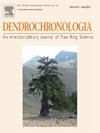利用过氧化氢改善亚化石木材年轮蓝强度的气候信号:以美国阿拉斯加湾为例
IF 2.7
3区 农林科学
Q1 FORESTRY
引用次数: 0
摘要
树木年轮的蓝色强度(BI)是最大晚木密度(MXD)的代表,已被广泛用于重建年生长季节的温度。BI记录比MXD记录更容易生成,因为它们的测量需要更少的资源,然而,对于具有与木材密度无关的色差的样品仍然存在障碍。特别是染色的亚化石原木和未染色的活树之间的颜色差异可能导致BI年代学的系统性变化,从而限制了古气候的重建。在这里,我们报告了一种很有前途的亚化石木材染色处理方法,使用过氧化氢(H2O2)处理高山铁杉(Tsuga mertensiana)原木,这些原木被冰川淹没,在阿拉斯加湾(GOA)沿岸的沉积物中保存了几个世纪。我们发现,在室温下用12 %过氧化氢(H2O2)浸泡24小时,可以最好地去除这种木材染色。漂白可能是通过铁单宁酸络合物中铁的氧化脱螯作用实现的,铁单宁酸络合物被认为是木色染色的来源。对60个跨越682年的样品进行漂白前后的BI测量表明,漂白导致BI指数的相互相关性得到改善。这包括三角洲BI的相关性高26 %,晚木BI的相关性高19 %,早木BI的相关性高7 %。治疗后δ BI测量的标准差也增加(0.071 ~ 0.090)。通过比较1050-1350 CE区间内基于环宽度的独立温度重建,我们进一步测试了浸泡后气候信号的潜在改善,从温度方差的角度来看,浸泡后所有BI参数的气候信号都有所改善。这包括后期木材BI提高19 %,三角洲BI提高5 %,处理后的早期木材BI提高12.5 %。此外,EPS和Rbar年表统计数据得到了显著改善,而且这种改善对所用的标准化相对不敏感。这项工作记录了H2O2染色如何改善山铁杉BI树年轮记录的发展,并可能有助于类似的BI年表,包括染色的亚化石样本。本文章由计算机程序翻译,如有差异,请以英文原文为准。
Improving the climate signal of tree-ring blue intensity of sub-fossil wood using hydrogen peroxide: An example from the gulf of Alaska, USA
Blue intensity (BI) in tree-rings is a proxy for maximum latewood density (MXD) and has been widely used to reconstruct annual growing-season temperatures. BI records are more easily produced than MXD because their measurement requires fewer resources, however, there remain obstacles with samples that have color differences not related to wood density. Color differences between stained sub-fossil logs and unstained living trees in particular can cause systematic shifts in BI chronologies and thus limit paleoclimate reconstructions. Here we report on a promising treatment for sub-fossil wood destaining using hydrogen peroxide (H2O2) on mountain hemlock (Tsuga mertensiana) logs that were overrun by glaciers and preserved in sediments for several centuries from sites along the Gulf of Alaska (GOA). We found that the removal of this taphonomic wood staining is best accomplished using a 24-h bath in 12 % hydrogen peroxide (H2O2) at room temperature. The bleaching may have been achieved through the oxidative de-chelation of the Fe species from the Fe-tannate complex which is thought to be the source of wood color stain. BI measurements made before and after bleaching of 60 samples spanning 682 years indicate that the destaining leads to an improved inter-correlation of BI indices. This included a 26 % higher correlation for delta BI, 19 % higher for latewood and 7 % greater for earlywood BI. The standard deviation for delta BI measurement also increased after the treatment (0.071–0.090). We further tested the potential improvement of the climate signal after soaking by comparing an independent temperature reconstruction based on ring-widths through the 1050–1350 CE interval, which showed an improved climate signal for all BI parameters in terms of the variance of temperature explained after soaking. This includes a 19 % higher improvement for latewood BI, 5 % higher for delta BI and 12.5 % higher with the post-treatment earlywood BI. Furthermore, EPS and Rbar chronology statistics were significantly improved and the improvement is relatively insensitive to the standardization used. This work documents how H2O2 destaining can improve the development of mountain hemlock BI tree-ring records and that it could potentially help in similar BI chronologies that include stained sub-fossil samples.
求助全文
通过发布文献求助,成功后即可免费获取论文全文。
去求助
来源期刊

Dendrochronologia
FORESTRY-GEOGRAPHY, PHYSICAL
CiteScore
5.50
自引率
13.30%
发文量
82
审稿时长
22.8 weeks
期刊介绍:
Dendrochronologia is a peer-reviewed international scholarly journal that presents high-quality research related to growth rings of woody plants, i.e., trees and shrubs, and the application of tree-ring studies.
The areas covered by the journal include, but are not limited to:
Archaeology
Botany
Climatology
Ecology
Forestry
Geology
Hydrology
Original research articles, reviews, communications, technical notes and personal notes are considered for publication.
 求助内容:
求助内容: 应助结果提醒方式:
应助结果提醒方式:


